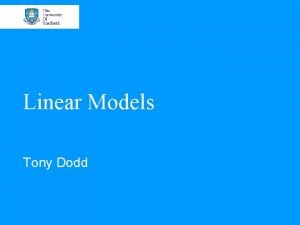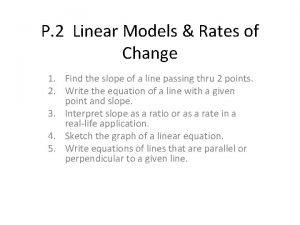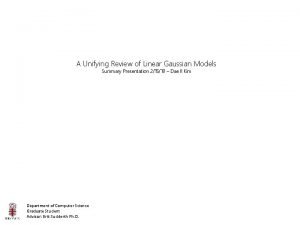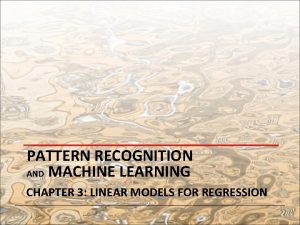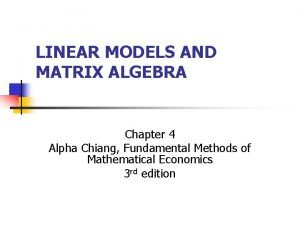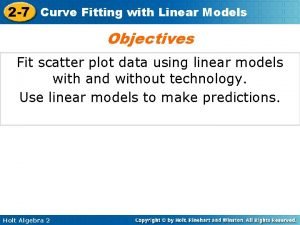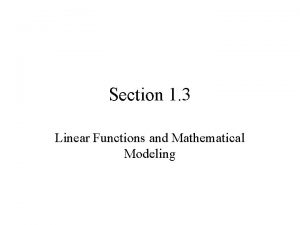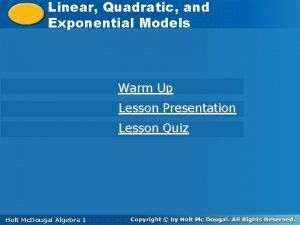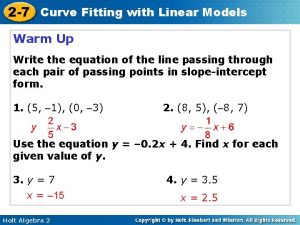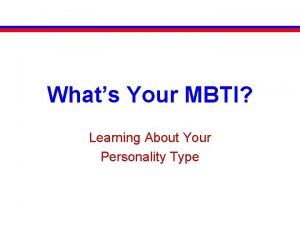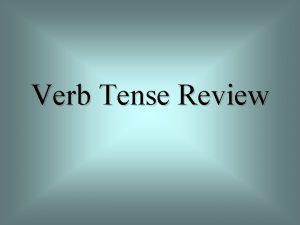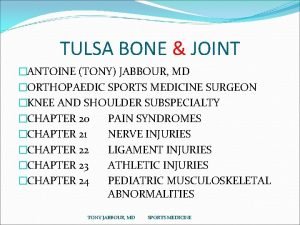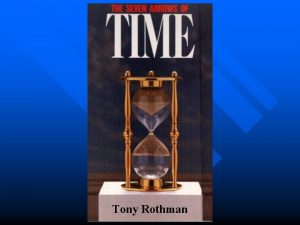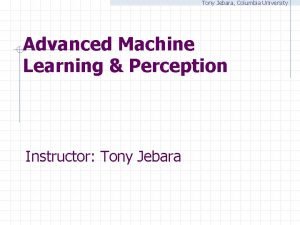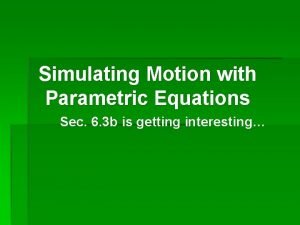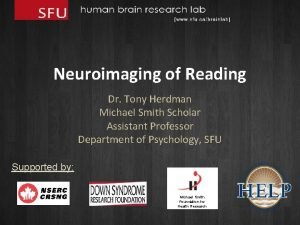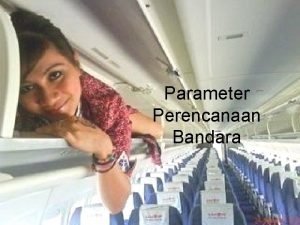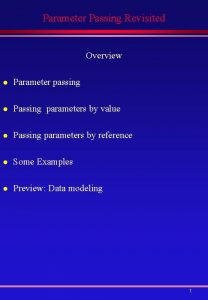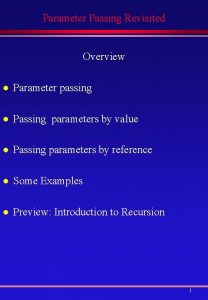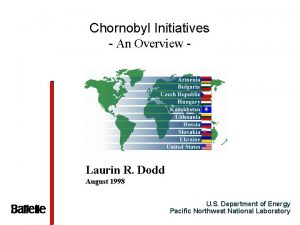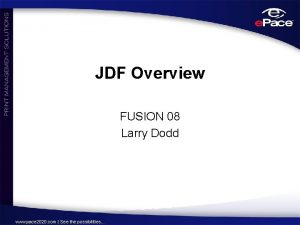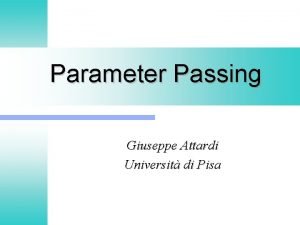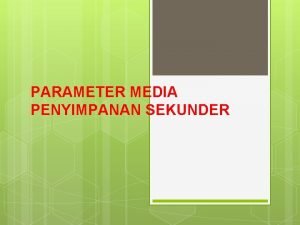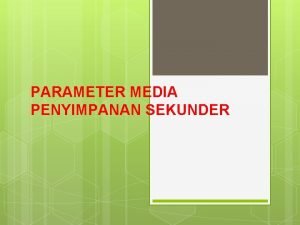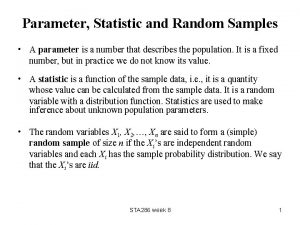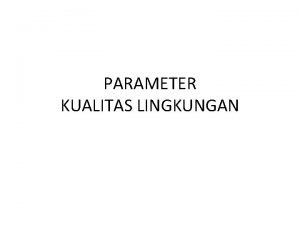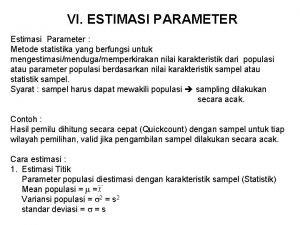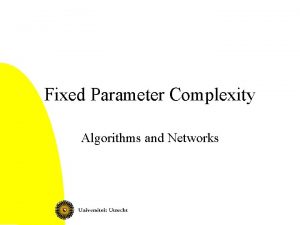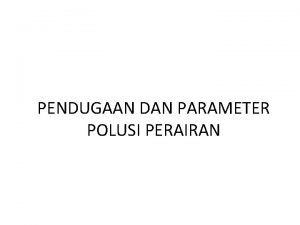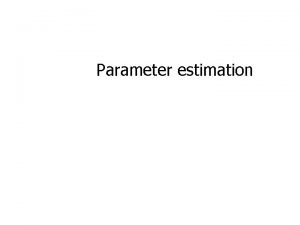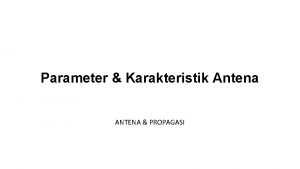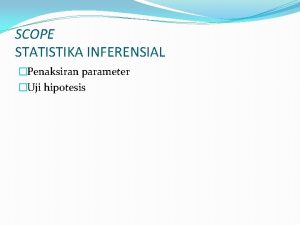Linear Models Tony Dodd Overview Linear models Parameter


































- Slides: 34

Linear Models Tony Dodd

Overview • Linear models. • Parameter estimation. • Linear in the parameters. • Classification. • The nonlinear bits. 24 -25 January 2007 An Overview of State-of-the-Art Data Modelling

Linear models • Linear model has general form where is the th component of input. • Assume and therefore is the bias. • Can represent lines and planes. • Should ALWAYS try a linear model first! 24 -25 January 2007 An Overview of State-of-the-Art Data Modelling

Parameter estimation • Least squares estimation. • Choose parameters that minimise • Unique minimum… • Optimum when noise is Gaussian. 24 -25 January 2007 An Overview of State-of-the-Art Data Modelling

Least squares cost function 24 -25 January 2007 An Overview of State-of-the-Art Data Modelling

Least squares parameters • Define the design matrix • Then the optimal parameters given by 24 -25 January 2007 An Overview of State-of-the-Art Data Modelling

Example 24 -25 January 2007 An Overview of State-of-the-Art Data Modelling

Example 24 -25 January 2007 An Overview of State-of-the-Art Data Modelling

Example 24 -25 January 2007 An Overview of State-of-the-Art Data Modelling

How can we generalise this? • Consider instead • Where inputs. is a nonlinear function of the • Nonlinear transform of the inputs and then form a linear model (more tomorrow). 24 -25 January 2007 An Overview of State-of-the-Art Data Modelling

Linear in the parameters • A nonlinear model that is often called linear. • Can apply simple estimation to the parameters. • But… it is nonlinear in the basis functions. 24 -25 January 2007 An Overview of State-of-the-Art Data Modelling

Parameter estimation • Define the design matrix • Then the optimal parameters given by 24 -25 January 2007 An Overview of State-of-the-Art Data Modelling

Example 24 -25 January 2007 An Overview of State-of-the-Art Data Modelling

Example 24 -25 January 2007 An Overview of State-of-the-Art Data Modelling

Example 24 -25 January 2007 An Overview of State-of-the-Art Data Modelling

Example – how does it work? 24 -25 January 2007 An Overview of State-of-the-Art Data Modelling

Example – how does it work? 24 -25 January 2007 An Overview of State-of-the-Art Data Modelling

Example – how does it work? Add all these together 24 -25 January 2007 An Overview of State-of-the-Art Data Modelling To get the function estimate

Example – when it all goes wrong More on this later. 24 -25 January 2007 An Overview of State-of-the-Art Data Modelling

Linear classification How do we apply linear models to classification – output is now categorical? • Discriminant analysis. • Probit analysis. • Log-linear regression. • Logistic regression. 24 -25 January 2007 An Overview of State-of-the-Art Data Modelling

Logistic regression • A regression model for Bernoulli-distributed targets. • Form the linear model where 24 -25 January 2007 An Overview of State-of-the-Art Data Modelling

Can we generalise it? • Instead of use a linear in the parameters model 24 -25 January 2007 An Overview of State-of-the-Art Data Modelling

Parameter estimation • Maximum likelihood. • Maximise the probability of getting the observed results given the parameters. • Although unique minimum need to use iterative techniques (no closed form solution). 24 -25 January 2007 An Overview of State-of-the-Art Data Modelling

Example 24 -25 January 2007 An Overview of State-of-the-Art Data Modelling

Example 24 -25 January 2007 An Overview of State-of-the-Art Data Modelling

Example 24 -25 January 2007 An Overview of State-of-the-Art Data Modelling

Example 24 -25 January 2007 An Overview of State-of-the-Art Data Modelling

Example – class probabilities 24 -25 January 2007 An Overview of State-of-the-Art Data Modelling

But… 24 -25 January 2007 An Overview of State-of-the-Art Data Modelling

Basis function optimisation Need to estimate: • Type of basis functions. • Number of basis functions. • Positions of basis functions. These are nonlinear problems – difficult! 24 -25 January 2007 An Overview of State-of-the-Art Data Modelling

Types of basis functions • Usually choose a favourite! • Examples include: Polynomials: Gaussians: … 24 -25 January 2007 An Overview of State-of-the-Art Data Modelling

Number of basis functions • How many basis functions? • Slowly increase number until overfit data. • Exploratory vs optimal. • More on this in the next talk. 24 -25 January 2007 An Overview of State-of-the-Art Data Modelling

Positions of basis functions • This is really difficult! • One easy possibility is to put one basis function on each data point. • Uniform grid (but curse of dimensionality). • Advantage of global basis functions e. g. polynomials – don’t need to optimise positions. 24 -25 January 2007 An Overview of State-of-the-Art Data Modelling

Concluding remarks • Always try a linear model first. • Can make nonlinear in the input but linear in the parameters. • But becomes nonlinear optimisation. • Is least squares/maximum likelihood the best way? 24 -25 January 2007 An Overview of State-of-the-Art Data Modelling
 Tony dodd
Tony dodd Difference between model and semi modal
Difference between model and semi modal Models of communication linear
Models of communication linear The hunkins model
The hunkins model Linear models and rates of change
Linear models and rates of change Linear model of communication example
Linear model of communication example A unifying review of linear gaussian models
A unifying review of linear gaussian models Linear basis function models
Linear basis function models Matrix multiplication linear algebra
Matrix multiplication linear algebra Four special cases in linear programming
Four special cases in linear programming Curve fitting with linear models
Curve fitting with linear models Linear functions as mathematical models
Linear functions as mathematical models Linear vs quadratic vs exponential
Linear vs quadratic vs exponential Linear functions as mathematical models
Linear functions as mathematical models Curve fitting with linear models
Curve fitting with linear models Goldie hawn mbti
Goldie hawn mbti Tony devolder
Tony devolder Vinco group
Vinco group Timeless present tense examples
Timeless present tense examples Tony rousmaniere
Tony rousmaniere Dr jabbour tulsa
Dr jabbour tulsa Tony rothman
Tony rothman Tony margeta
Tony margeta Tony jebara
Tony jebara Tony camilli
Tony camilli Pitfalls of object oriented programming
Pitfalls of object oriented programming Thinking keys
Thinking keys Tony movshon
Tony movshon Tony's safe place
Tony's safe place Tony and sue are launching yard darts
Tony and sue are launching yard darts Is the patriarch of the hard castle family
Is the patriarch of the hard castle family Tony dickherber
Tony dickherber Tony berthaud
Tony berthaud Tony herdman
Tony herdman Green line 1 abc rap
Green line 1 abc rap
